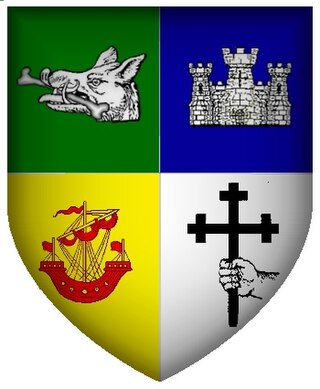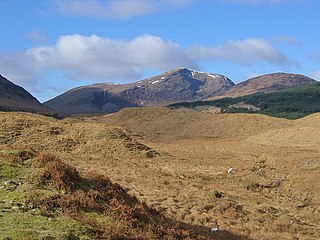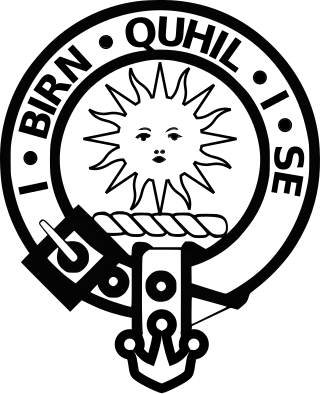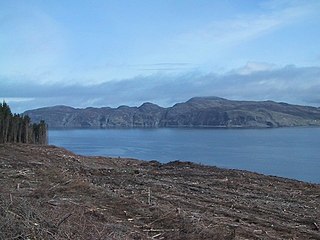Related Research Articles

Lord of the Isles or King of the Isles (Scottish Gaelic:Triath nan Eilean or Rìgh Innse Gall;Latin:Dominus Insularum) is a title of nobility in the Baronage of Scotland with historical roots that go back beyond the Kingdom of Scotland. It began with Somerled in the 12th century and thereafter the title was held by a series of his descendants,the Norse-Gaelic rulers of the Isle of Man and Argyll and the islands of Scotland in the Middle Ages. They wielded sea-power with fleets of galleys (birlinns). Although they were,at times,nominal vassals of the kings of Norway,Ireland,or Scotland,the island chiefs remained functionally independent for many centuries. Their territory included much of Argyll,the Isles of Arran,Bute,Islay,the Isle of Man,Hebrides,Knoydart,Ardnamurchan,and the Kintyre peninsula. At their height they were the greatest landowners and most powerful lords after the kings of England and Scotland.

Clan Donald,also known as Clan MacDonald or Clan Mc Donald,is a Highland Scottish clan and one of the largest Scottish clans. The Lord Lyon King of Arms,the Scottish official with responsibility for regulating heraldry in that country,issuing new grants of coats of arms,and serving as the judge of the Court of the Lord Lyon,recognises under Scottish law the High Chief of Clan Donald. Historically the chiefs of the Clan Donald held the title of Lord of the Isles until 1493 and two of those chiefs also held the title of Earl of Ross until 1476.

Clan Maclean is a Highlands Scottish clan. They are one of the oldest clans in the Highlands and owned large tracts of land in Argyll as well as the Inner Hebrides. Many early MacLeans became famous for their honour,strength and courage in battle. They were involved in clan skirmishes with the Mackinnons,Camerons,MacDonalds and Campbells,as well as all of the Jacobite risings.

Clan Mackay is an ancient and once-powerful Highland Scottish clan from the far North of the Scottish Highlands,but with roots in the old Kingdom of Moray.

Clan Maclaine of Lochbuie is a Scottish Clan that inhabited lands on the southern end of the Isle of Mull in the Inner Hebrides of the western Scottish Highlands. "Maclaine" is an alternate spelling for "MacLean." Clan Maclaine of Lochbuie and Clan Maclean of Duart are two separate clans which share a strong family connection. The 26th clan chief is Lorne Gillean Ian Maclaine of Lochbuie,Baron of Moy. The clan is recognised by both the Standing Council of Scottish Chiefs and the Lord Lyon.

Clan Mackintosh is a Scottish clan from Inverness in the Scottish Highlands. The chiefs of the clan are the Mackintoshes of Mackintosh. Another branch of the clan,the Mackintoshes of Torcastle,are the chiefs of Clan Chattan,a historic confederation of clans.

Clan MacDonell of Glengarry,also known as Clan Ranald of Knoydart &Glengarry is a Highland Scottish clan and is a branch of the larger Clan Donald. The clan takes its name from River Garry where the river Garry runs eastwards through Loch Garry to join the Great Glen about 16 miles (25 km) north of Fort William,Highland. The progenitor of the MacDonells of Glengarry is Reginald,4th great-grandson of the warrior Somerled.

Clan MacDougall is a Highland Scottish clan,historically based in and around Argyll. The Lord Lyon King of Arms,the Scottish official with responsibility for regulating heraldry in Scotland,issuing new grants of coats of arms,and serving as the judge of the Court of the Lord Lyon,recognizes under Scottish law the Chief of Clan MacDougall. The MacDougall chiefs share a common ancestry with the chiefs of Clan Donald in descent from Somerled of the 12th century. In the 13th century the Clan MacDougall whose chiefs were the original Lords of Argyll and later Lords of Lorne was the most powerful clan in the Western Highlands. During the Wars of Scottish Independence the MacDougalls sided with the Clan Comyn whose chiefs rivaled Robert the Bruce for the Scottish Crown and this resulted in clan battles between the MacDougalls and Bruce. This marked the MacDougall's fall from power and led to the rise of their relatives,the Clan Donald,who had supported Bruce and also the rise to power of the Clan Campbell who were then the habitual enemies of the MacDougalls and later of Clan Donald.

Clan MacKinnon is a Highland Scottish clan from the islands of Mull and Skye,in the Inner Hebrides.

The Battle of Dalrigh,also known as the Battle of Dail Righ,Battle of Dalry or Battle of Strathfillan,was fought in 1306 between the army of King Robert the Bruce against Clan MacDougall of Argyll,who were allies of Clan Comyn and the English. It took place at the hamlet of Dalrigh near Tyndrum in Perthshire,Scotland. Bruce's army,reeling westwards after defeat by the English on 19 June at the Battle of Methven,was intercepted and all but destroyed,with Bruce himself narrowly escaping capture. The battle took place sometime between July and early August,but the exact date is unknown.
The MacDonalds of Ardnamurchan,also known as MacIain of Ardnamurchan,or Clan MacIan,were a Scottish family and a branch of the larger Clan Donald.

Alexander of Islay or Alexander MacDonald was a medieval Scottish nobleman who succeeded his father Domhnall of Islay as Lord of the Isles (1423–1449),later rising to the rank of Earl of Ross (1436–49). His lively career,especially before he attained the earldom of Ross,led Hugh MacDonald,the 17th century author of History of the MacDonalds,to commemorate him as "a man born to much trouble all his lifetime". Alexander allied himself with King James I of Scotland against the power of the Albany Stewarts in 1425 but,once the Albany Stewarts were out of the way,Alexander quickly found himself at odds with the new king. War with King James would initially prove Alexander's undoing,and would see the King's power in Scotland greatly increased,but at the Battle of Inverlochy Alexander's army prevailed against the forces of the King. Alexander died in 1449,having greatly extended his family's landed wealth and power. He was buried,not in the Isles of his ancestors,but at Fortrose Cathedral in his mainland Earldom of Ross.

Clan MacLeod of The Lewes,commonly known as Clan MacLeod of Lewis,is a Highland Scottish clan,which at its height held extensive lands in the Western Isles and west coast of Scotland. From the 14th century up until the beginning of the 17th century there were two branches of Macleods:the MacLeods of Dunvegan and Harris;and the Macleods of the Isle of Lewis. In Gaelic the Macleods of Lewis were known as Sìol Thorcaill,and the MacLeods of Dunvegan and Harris were known as Sìol Thormoid.

The Battle of Bloody Bay,or Blàr Bàgh na Fala in Scottish Gaelic,was a naval battle fought near Tobermory,Scotland. It was fought on the coast of Mull 2 miles north of Tobermory,between John MacDonald of Islay,the Lord of the Isles and chief of Clan Donald;and his son,Angus Og Macdonald. The precise date of the battle varies in sources,from 1480 to 1483. After the battle,in which Angus Og Macdonald emerged victorious,the latter seized power from his father,and held it for the rest of the decade. However,Angus's victory would prove pyrrhic. Many clansmen had died in the battle and nearly half the clan's fleet had been sunk,as a result of which the power of the Lords of the Isles was henceforth greatly diminished. Angus,last of the independent Lords of the Isles,would himself be murdered in 1490.

The Battle of Traigh Ghruinneart or in Scottish Gaelic Blàr Tràigh Ghruineart or sometimes called the Battle of Gruinart Strand was a Scottish clan battle fought on 5 August 1598,on the Isle of Islay,in the Hebrides. It was fought between the Clan Donald and Clan Maclean. A tràigh or stand is the flat area of land bordering a body of water,a beach,or shoreline.
Lachlan Bronnach MacLean,was the 7th Chief of Clan MacLean.
Malise mac Gilleain was the second chief of Clan Maclean. He was loyal to Alexander III of Scotland and assisted in the expulsion of Haakon IV of Norway from Scotland.
John Dubh Maclean,or Iain Dubh mac Gilliemore in Scottish Gaelic,or John Maclean the Black was the 4th Chief of Clan MacLean.
Lachlan Catanach Maclean was the 11th Clan Chief of Clan MacLean from 1515 until his murder in 1523.

Sir Lachlan Mór Maclean or Big Lachlan Maclean,was the 14th Clan Chief of Clan MacLean from late 1573 or early 1574 until 1598. Mór or Mor translates as big in English,or magnus in Latin,when added to a name in Scottish Gaelic.
References
![]() This article incorporates text fromA history of the clan Mac Lean from its first settlement at Duart Castle,in the Isle of Mull,to the present period:including a genealogical account of some of the principal families together with their heraldry,legends,superstitions,etc,by John Patterson MacLean,a publication from 1889,now in the public domain in the United States.
This article incorporates text fromA history of the clan Mac Lean from its first settlement at Duart Castle,in the Isle of Mull,to the present period:including a genealogical account of some of the principal families together with their heraldry,legends,superstitions,etc,by John Patterson MacLean,a publication from 1889,now in the public domain in the United States.
- 1 2 "One Clan, Two Families". Clan Maclean . Retrieved 24 March 2009.
Gilli Colium mac maoiliosa - or Malcolm son of Maoiliose - married Rignach, a relation of Robert Bruce, Lord of Carrick. This set up a dynastic link to the powerful Bruce family and from this marriage there appears to have been three sons Donald, Neil and John (Iain Dubh in Gaelic), all of whom were active in 1326 when they appear in the Exchequer Rolls of that year. The family link to the Bruce family must have benefited the emergent kindred or clan now calling itself MacGille eoin (Maclean) as Neil was appointed Constable of the royal castle of Scraburgh (possibly Tarbet) in 1329, while his elder brother, Donald, appears to have been a commander of the Kings galleys and John (Iain Dubh) can be found at Sael (Seil) Castle in Lorn - another royal stronghold.
- 1 2 MacLean, John Patterson (1889). A History of the Clan MacLean from Its First Settlement at Duard Castle, in the Isle of Mull, to the Present Period: Including a Genealogical Account of Some of the Principal Families Together with Their Heraldry, Legends, Superstitions, Etc. R. Clarke & Company. p. 32.
Laird of Brolas.